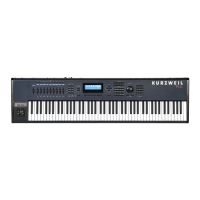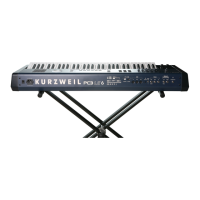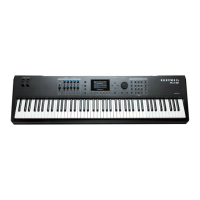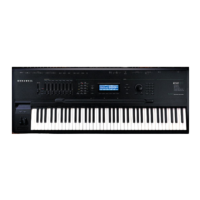Keymap and Sample Editing
Building a Keymap
14-7
Building a Keymap
Readbelowfordetaileddirectionsonmanuallycreatingandeditingakeymap.(Seethepreview
functiononpage 11‐17forawaytoautomaticallycreateaprogramandkeymap.)Tobuilda
keymap,firstgototheProgrammodemainpage(thiscanbedonebyrepeatedlypressingthe
Exitbutton.)
FromtheProgrammodemainpage,usethealphanumericpadtoselectprogram
999DefaultProgram.NextpresstheEditbuttontoentertheProgramEditor.Pressthe
KEYMAPsoftbutton,andtheKEYMAPpagewillappear.TheKeymapparameterwillbe
automaticallyselected.Press999andEnteronthe
alphanumericpadtoassignthekeymap999
Silence.Thisisn’tabsolutelynecessary,butitmakesiteasiertorecognizethekeyrangesthat
havesamplesassignedtothemwhenyoustartassigningsamples.Youcanactuallychooseany
programorkeymapyouwanttostartwith,butbychoosingthese,
youarestartingwitha
“blankslate.”
WiththeKeymapparameterstillselected,presstheEditbutton,andyou’llentertheKeymap
Editor.TheKeyRangeparameterwillbeautomaticallyselected,andyouseeitsvalues:C0to
G10(theentireMIDIkeyboardrange).TheSampleparameterwillhaveavalue
of
999 Silence‐C4.
Nowyou’rereadytostartassigningsamplestokeyrangeswithinthekeymap.We’llassume
thatyou’veloaded sampleswithrootsatC1,C2,C3,etc.andthatyouplantoassignarootto
eachoctave.Tobegin,presstheAssignsoftbutton.
Thedisplaywillpromptyoutoselecta
sample.UsetheAlphaWheeltoscrolltooneofyoursamples,ortypeitsIDonthe
alphanumericpadandpressEnter.Whenyou’vefoundthesampleyouwanttouse,pressthe
OKsoftbutton.Thedisplaywillsay“Strike
lowkey…”TriggerA0(MIDInotenumber21,the
lowestAonastandard88‐notekeyboard).Thedisplaywillchangetosay“StrikeHigh
Key…”NowtriggerF1(MIDInotenumber29).ThedisplaywillreturntotheKeymap‐editor
page.TheKeyRangeparameterwillshowA0–F
1,andtheSampleparameterwillshowthe
sampleyouselectedwhenyoustartedtherangeassignment.
Eachsampleinakeyrangeisautomaticallytransposedbasedoneachsample’sRootKey
parametersothatitplaysatthecorrectpitchonthekeyboardrelativetoitsrootkey(seeEditing
Samples on page 14‐9fordetailsontheRootKeyparameter.)Otherkeyswithinthekeyrange
transposethesamplechromaticallyrelativetotherootkey.Automatictranspositionbasedon
eachsample’sRootKeyisimportantifyouwantyoursampletoplayintunewithotherPC3K
programsorotherinstruments.ThePC3K
makesthiseasyifyoursampleshavethecorrect
RootKeysettings(asthePC3K’sfactorysamplesdo.)Generallyyoushouldsetakeyrangeso
thatthesample’sRootKey(displayedattheendofthesamplename)isinthemiddleofthe
range.Ifyousetakeyrangethatdoes
notcoverthesample’sRootKey,thesamplewillhaveto
automaticallytransposebymanysemitones,andwilllikelynotsoundcorrect.Samplesarealso
limitedtoan octaveofupwardtransposition fromthesample’soriginalpitch.Ifyouseta
keyrangetoohighbasedontheRootKey,somesamples
maynotbeabletotransposeupward
farenoughtoplayintune,andmanykeysmayplaythesamenote(thehighestnotethatthe
samplecanbetransposedto.)Automatictranspositionrelativetotherootkeycanbeoffset
usingtheCoarseTuneandFineTuneparametersonthe
EditKeymappage,(seeCoarseTuneand
FineTune on page 14‐4.)
Continuingwiththeexample,presstheAssignsoftbuttonagain.Selectanothersamplerootat
theprompt,andpresstheOKsoftbutton.NowtriggerF#1fortheLowKeyprompt,andF2for
theHighKeyprompt.At
thispointyou’vedefinedtwokeyranges,thefirstfromA0toF1,and
thesecondfromF#1toF2.Youcanrepeattheprocessasmanytimesasyouwant,creatinga
newkeyrangeeachtime.
Onceyouhaveyoursamplesassigned,youmayneed
totransposethemsothattheyplayback
atthecorrectpitchwithintherangeyouhavechosen.Todothis,highlighttheKeyRange
parameter,scrolltotherangeyouneed,thenhighlighttheCoarseTuneparameter.Adjust
CoarseTunetobringthesampletotheproperpitchwithinthat
keyrange.Thenscrollbackup
totheKeyRangeparameter,selectthenextrange,andcontinueasneeded.
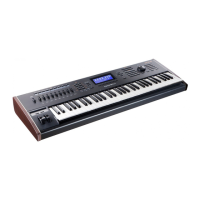
